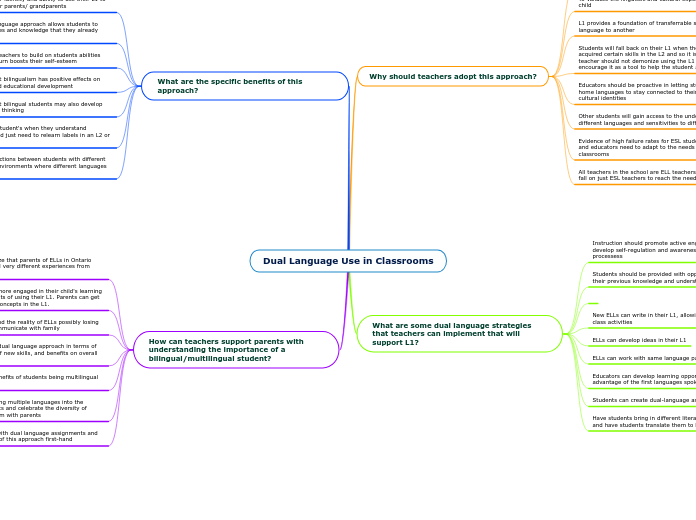Dual Language Use in Classrooms
Why should teachers adopt this approach?
To create an inclusive environment and celebrate the diversity and talents of students within the classroom
To validate the linguistic and cultural experiences of the whole child
L1 provides a foundation of transferrable skills from one language to another
Students will fall back on their L1 when they have not yet acquired certain skills in the L2 and so it is imperative that the teacher should not demonize using the L1 but should encourage it as a tool to help the student acquire new skills
Educators should be proactive in letting students retain their home languages to stay connected to their families and cultural identities
Other students will gain access to the understandings of different languages and sensitivities to different cultures
Evidence of high failure rates for ESL students across Canada and educators need to adapt to the needs of today's classrooms
All teachers in the school are ELL teachers and it should not fall on just ESL teachers to reach the needs of all students
What are some dual language strategies that teachers can implement that will support L1?
Instruction should promote active engagement for students to develop self-regulation and awareness of their learning processess
Students should be provided with opportunities to build on their previous knowledge and understanding
New ELLs can write in their L1, allowing them to be involved in class activities
ELLs can develop ideas in their L1
ELLs can work with same language partners
Educators can develop learning opportunities that take advantage of the first languages spoken in the class
Students can create dual-language assignments
Have students bring in different literacy pieces from their L1s and have students translate them to English
What are the specific benefits of this approach?
Students maintain their identity and ability to use their L1 to communicate with their parents/ grandparents
A multilingual/ dual language approach allows students to build on the experiences and knowledge that they already know
This approach allows teachers to build on students abilities and talents, which in turn boosts their self-esteem
Research indicates that bilingualism has positive effects on children's linguistic and educational development
Research suggests that bilingual students may also develop more flexibility in their thinking
Learning is easier for student's when they understand concepts in their L1 and just need to relearn labels in an L2 or L3.
Increased social interactions between students with different L1's create inclusive environments where different languages are celebrated
How can teachers support parents with understanding the importance of a bilingual/multilingual student?
Educators should recognize that parents of ELLs in Ontario classrooms may have had very different experiences from Ontario-born parents
Help parents to become more engaged in their child's learning by telling them the benefits of using their L1. Parents can get students to explain new concepts in the L1.
Help parents to understand the reality of ELLs possibly losing their L1 and ability to communicate with family
Explain the benefits of a dual language approach in terms of self-esteem, acquisition of new skills, and benefits on overall cognitive development
Explain to parents the benefits of students being multilingual in the globalized world
Explain the value of inviting multiple languages into the classroom for ALL students and celebrate the diversity of languages in the classroom with parents
Parents can be involved with dual language assignments and see some of the benefits of this approach first-hand
